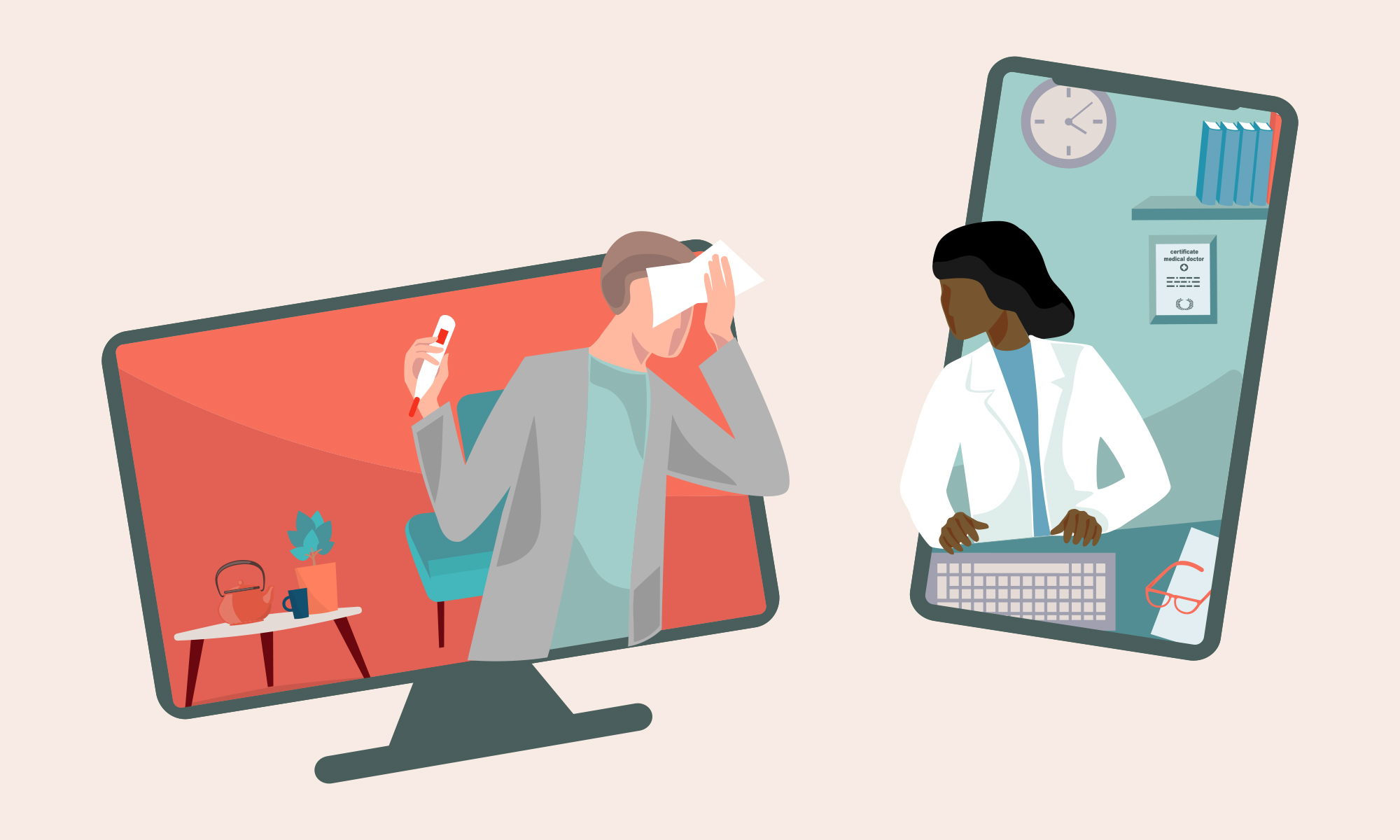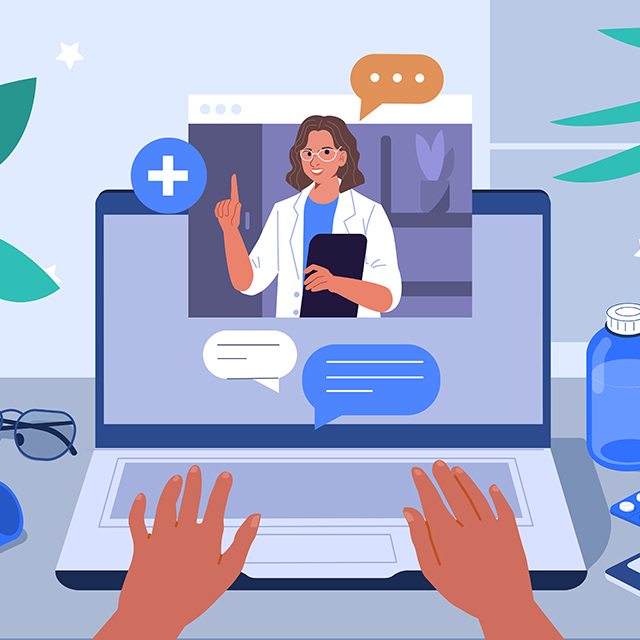Since the start of the COVID-19 pandemic, Johns Hopkins Medicine practitioners have conducted more than 1.5 million telemedicine visits with over 420,000 patients in Maryland, Washington, D.C., Florida and elsewhere across the country, according to the Johns Hopkins Office of Telemedicine.
“The adoption of telemedicine use was a dream come true in a nightmare scenario,” says Rebecca Canino, executive director of the Office of Telemedicine. “I’m just so grateful to Johns Hopkins leadership for not only foreseeing the need for this, but investing in it early so that we were ready to support the sudden demand.”
While some medical visits must be in person, approximately 60% of Johns Hopkins practitioners have used telemedicine at least once since March 2020, according to the telemedicine office.
“It’s really become part of routine outpatient care,” adds Helen Hughes, the office’s medical director. “Now it’s our job to figure out how to make it the best that it can be and make sure that we’re offering the best clinically and technically.”
Some practitioners have performed a handful of telemedicine visits while others have done thousands. Some had never seen a patient virtually before the pandemic, and others were already practicing remote care. Below, three clinicians discuss how using telemedicine has changed their practices.
Risa Wolf
Associate professor, Division of Endocrinology, Department of Pediatrics
Risa Wolf was the first pediatric subspecialty practitioner at Johns Hopkins Children’s Center to use telemedicine. It was part of a pilot program in 2018 with the health department in Talbot County, Maryland, to see Eastern Shore patients for follow-up visits.
Today, she sees a quarter of her patients via telemedicine, including about one-third of her patients who have diabetes. Wolf generally alternates in-person and telemedicine visits with these patients, who are seen every three months for follow-up care.
“At the start of the pandemic, we transitioned a lot of follow-up care to telemedicine, and diabetes lends well to this because many of our patients with diabetes use technologies such as continuous glucose monitors, insulin pumps and hybrid closed loop systems that upload data to secure platforms that we can view remotely without the patient present,” Wolf says.
During the school year, Wolf schedules early morning telemedicine appointments before families go to work and school, and parents appreciate after-school virtual appointments instead of having to take children out of school early to go to the office.
Wolf has developed a system in which height and weight measurements and physical exam findings are reported by her patients or their parents as part of a virtual visit, and then she performs a comprehensive exam during an in-person visit. Wolf shares her computer screen with patients during both types of appointments to review clinical data and results.
“Telemedicine can be an effective platform for patient care,” Wolf says, with many benefits for both patients and practitioners. She says it saves time and money for the patient, and it can allow the practitioner “to be more efficient in transitioning from patient to patient in a clinic setting.”
Denis Antoine
Director, Center for Addiction and Pregnancy, Johns Hopkins Bayview Medical Center
Assistant professor, psychiatry and behavioral sciences
Denis Antoine went from seeing no patients virtually in March 2020 to seeing every patient virtually one month later. That’s because Antoine oversees a clinic in Baltimore housed in the Helping Up Mission, which helps men and women fight homelessness and addiction.
“There was a high risk of COVID transmission to other clients in the area and also to our staff, so we needed to make something that was safe but still kept the high amount of services that we needed,” he says. “Telehealth was the only way we could think of to keep things going.”
Antoine purchased Wi-Fi and equipment for the Helping Up Mission’s building in East Baltimore through a grant provided by the Johns Hopkins Urban Health Institute, and his team developed a streamlined technical workflow. Patients only need to click on an icon to log in for their appointment.
As a psychiatrist and addictionologist, Antoine’s biggest concern about starting telemedicine was whether he could obtain the information remotely that he needed from his patients. But many patients have been more open on Zoom, he says, because they feel more at ease speaking from their own environment.
“I can just say, ‘Hey, I’m going to be [The Joy of Painting host] Bob Ross, and I’m going to paint a picture of your life and we’re going to talk about that,’ and that works,” Antoine says. “And for a lot of folks who are coming to my virtual sessions, they have never seen a therapist or psychiatrist before. So, I’m just easing them into the process and making them more comfortable.”
One thing he will apply from his telemedicine visits to in-person visits is to have patients provide more information before their meeting so he is typing less; patients during virtual visits do not see his keyboard, which has been less distracting.
Antoine and his staff have appreciated the flexibility of telemedicine and will continue to use it, while meeting patients in person for more complex cases.
“One day, I was seeing a patient, then I had to go be director of another clinic, so I just swiveled my chair,” he says. “And then, a half-hour later, I was testifying at the state Senate for a bill. You can do a lot without having to drive back and forth to different locations.”
Sherilyn Brinkley
Nurse practitioner and program manager of clinical services and research, Viral Hepatitis Center
Sherilyn Brinkley started using telemedicine more than four years ago to provide specialized infectious disease services to parts of rural Western Maryland. The program was firmly established by March 2018, with most patients going to a local health department and working on-site with a Johns Hopkins nurse who assisted with virtual visits.
Brinkley says she was initially concerned that her patients would feel like they were receiving impersonal and noncomprehensive care through telemedicine, particularly since building trust is crucial for the patient population there.
“What really helped our programs quickly become successful is the fact that we did have that bridge with our practice of having a nurse there, who really smoothed all those pieces out for us,” she says. “Now, so many people are comfortable with the idea of having a video visit.”
The pandemic, however, forced patients to obtain care virtually from their homes, Brinkley says. Some do not have Wi-Fi or computers, and they use smartphones for video or audio calls. She estimates she now sees 85% of her patients on video and more than half of her patients overall via telemedicine. She is helping patients access hepatitis C treatment services and stabilize their opioid use, as well as treating substance use disorder with buprenorphine-naloxone.
“I’m able to get to people who are not able to get to traditional medical care in their communities,” she says. “The most gratifying part of [using telemedicine] is that we’re helping people who wouldn’t otherwise be able to get this care, and people are exceedingly grateful. That word of mouth is what’s really driven our program over time.”
Brinkley says telemedicine has given her an appreciation of the obstacles some patients need to overcome to get to in-person appointments. Telemedicine will not replace them entirely, she adds, but it will continue to be “absolutely critical” to treating patients.
“It’s not going to go away, and there are many people who greatly benefit from this model of care,” she says.
Looking ahead, Hughes says the office of telemedicine wants to grow its remote patient monitoring capabilities into ambulatory and complex care, allowing for more proactive care of patients at home. And as digital health care tools are used more routinely, it is more important than ever to ensure equitable access to health care. The office, staffed by a dozen people with a combination of administrative, clinical and information technology backgrounds, is working with Johns Hopkins leadership and the Baltimore mayor’s office to help make digital health tools more accessible for everyone.
Telemedicine also will be used to make specialty care more available to patients at Johns Hopkins Medicine hospitals, Hughes says, “to keep patients in the right beds, within their communities and close to their support systems, and to avoid unnecessary transfers.” The idea is to connect patients at any Johns Hopkins hospital to specialized practitioners at the East Baltimore campus via video, also known as teleconsultation. A pilot project, for example, is remotely connecting patients in Johns Hopkins Bayview Medical Center’s neonatal intensive care unit with pediatric specialists at The Johns Hopkins Hospital.
“The overall goal is that no matter where you go in the Johns Hopkins Health System, you get the same high level of access to our specialty and subspecialty care,” says Canino.


